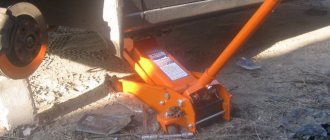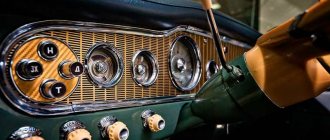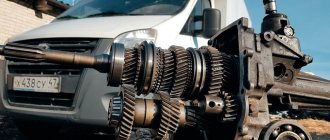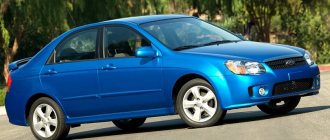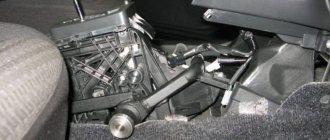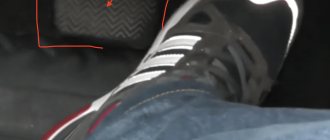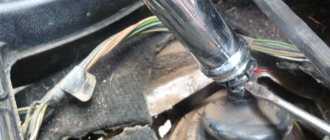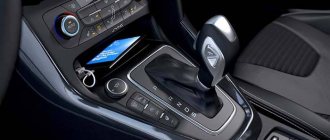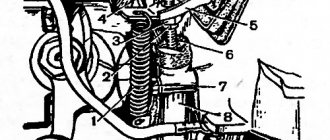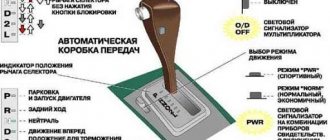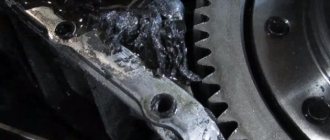Every driver who has driven a car with an automatic transmission for at least a month is sure that he has thoroughly studied his transmission. However, there are at least three automatic buttons that the vast majority of motorists have never even heard of and never use. What functions are hidden there and how can they be useful?
Question answer
Why are automatic transmissions more economical than manual transmissions?
What is the button on the automatic transmission handle for?
As you know, automatic transmissions are widely used today. Moreover, the modern automobile industry offers a large selection of different types of automatic and semi-automatic transmissions (“classic” hydromechanical automatic transmissions, CVT variators, automatic manual transmissions such as AMT and preselective dual-clutch transmissions).
At the same time, even despite the attempts of manufacturers to simplify the overall process of interaction with the automatic transmission selector as much as possible, owners still encounter difficulties. Often, when changing to a car with an automatic transmission, drivers do not know the purpose of certain additional modes, function buttons, etc.
In this article we will talk about what the button on the automatic transmission lever is needed for and what it is responsible for, as well as what other additional buttons can be found on the selector lever of various automatic transmissions.
Read in this article
This is interesting: How to turn off the Tomahawk z5 alarm without a key fob
Why do you need overdrive on an automatic transmission?
If we consider the design of an automatic transmission with 4 gears (steps, speeds), in this case the 3rd gear is direct, that is, it has a gear ratio of 1, which is similar to the 4th gear of a manual transmission.
In this case, 4th gear in an automatic transmission is also called overdrive or O/D. By analogy with mechanics, the gear ratio of this gear is less than 1, that is, an overdrive gear, like 5th gear in a manual transmission.
As you know, manual overdrive is engaged at speeds of 80 or even 100 km/h. This transmission allows you to significantly save fuel when driving along the highway at high speed. In the case of an automatic transmission, where the driver cannot change gears independently, the O/D (overdrive) mode is separately turned on and off using a separate button.
The overdrive button can be located on the automatic transmission selector or placed separately. So, if automatic transmission overdrive is turned on, this means that the automatic transmission will switch to 4th (higher) gear at high speeds, and also if the driver lightly presses the gas pedal. After engaging 4th gear, the torque converter lockup is activated.
In practice, switching to 4th occurs already at a speed of about 45-50 km/h. It is quite obvious that 4th gear allows you to save fuel when driving on the highway, and also does not allow the engine to spin up to too high speeds.
However, many car owners have a question about what to do if the car is used within the city. In other words, do you need to turn on O\D in the city or turn off overdrive? Let's figure it out.
Overdrive mode on automatic transmission: how to use
So, if we consider all the arguments for and against, we can highlight the following:
- If the overdrive mode is turned on, 4th gear is engaged as early as possible, that is, fuel is saved;
- The engine operates less at high speeds, saving the life of the internal combustion engine;
- The operating instructions for various brands of cars specifically indicate that in difficult conditions the O/D mode must be turned off. At the same time, city driving with frequent stops and accelerations, overtaking and lane changes may well be considered difficult conditions.
- Also, in O/D mode, the automatic transmission switches to 4th gear more often, thereby increasing wear on the gearbox mechanisms. In parallel with overdrive turned on, the effect of engine braking is weakly expressed.
It becomes clear that when driving on the highway at a constant high speed, a higher gear (overdrive) must be engaged, since in this case the engine and gearbox operate in optimal mode, maximum fuel efficiency is achieved, etc.
If you turn off overdrive, the ability to switch to a gear higher than 3 is blocked. Also, switching to higher gears after the start occurs at increased engine speeds; when braking, the gearbox “holds” the gear engaged longer, that is, downshifting occurs only when a certain engine speed and speed are reached movements.
We also recommend reading the article about why the automatic transmission pushes, jerks or kicks when changing gears. From this article you will learn about the main reasons for the appearance of automatic transmission kicks, jolts or impacts in different operating modes.
By the way, you need to turn off O/D during prolonged overtaking at high speeds (more than 100 km/h). At the same time, briefly turning off the overdrive also allows you to do a kick-down, that is, when the driver sharply and strongly presses the gas pedal.
Also, overdrive should be turned off when towing a trailer, when driving on snow, ice, off-road, etc. Overdrive also needs to be turned off if, due to road conditions, you need to get the effect of engine braking.
In practice, if we talk about everyday use within the city, it is better to turn off overdrive on an automatic transmission. This can be done with a button located separately or on the gearshift lever. At the same time, O/D off lights up on the dashboard, which means 4th gear is disabled. If overdrive is turned on, nothing lights up on the dashboard.
https://youtube.com/watch?v=yJojxTWbBn8
Main (large) button
Big button
VAZ automatic
The main large key is needed to change gears. Without pressing it, you will not be able to change gears on an automatic transmission. On my AVEO, this button is made in such a way that whether you want it or not, you have to press it.
need to press
gear change
Why such buttons for fixing the automatic transmission lever are needed, everything is simple - this is done so as not to accidentally move the selector to an unnecessary position, for example, if you hit it with your hand or dropped something, and a child might pull it. And if you suddenly shift the lever into reverse gear at speed, then it’s not far from a breakdown. This is what the main big button on the automatic transmission lever is for. In principle, this is elementary and everyone knows it.
Gear shift lever on the steering column
This automatic transmission shift paddle is similar to the classic transmission shift knob that was installed on the steering column in many older cars. In the modern world, Mercedes-Benz was the first to remember it. This lever is similar to the switch handles for windshield wipers and turn signals. This automatic transmission knob also has a classic operating mode scheme: PRNDL.
But thanks to new technologies, this pen is electronic, not mechanical. Gear shifting occurs by moving the handle. However, to move it, you need to press a button.
How to use "Shift lock"
In order for the button to have the desired effect, you must take the following steps:
- Click on it.
- Do not release until you have moved the shift lever to the “N” position if you need to tow the vehicle with another vehicle.
- Release the button on the machine.
- Then you can push the car or transport it on a trailer.
Read
Which automatic transmission is the most reliable and best, rating of automatic transmissions
Now you know how and where to use this key. It may look different on different brands of vehicles.
For example:
- on Toyota cars you will find it slightly recessed into the selector. And it will be called not just Shift Lock, but “Shift Lock Release”;
- on Kia the switch will be hidden under a special panel. The lid must be opened to use the “Shift lock”;
- There are no identification marks on the Ford Focus and other modifications of vehicles that came off the assembly line of a well-known plant. On the automatic transmission selector of these cars you will find just a button without a name;
- on Nissan Shift Lock looks exactly the same as on Toyota.
Read
Parking with an automatic transmission: parking modes and proper parking with an automatic transmission for beginners
If you need to replace the button, you can contact any auto store. The cost of a key starts from 130 rubles. For Toyota Camry ShiftLock is sold under catalog number 3356333230.
List of situational moments that require turning on the button
However, if the automatic transmission has gone into emergency mode or the engine has stalled in the middle of a busy highway, you can safely use Shift Lock to, for example, set the rocker to the neutral position. It will be easier for another car to tow your box without harm if there is no tow truck nearby.
Read
Typical problems and repairs of automatic transmission f4a42
Now I will describe situations in which the use of “Shift Lock” on an automatic transmission will be useful to you:
- stopping at a gas station;
- car breakdown requiring towing, as I wrote above;
- stopping in front of the turnstile to deposit money.
Thanks to this key, you can always unlock the automatic transmission and put the rocker in the desired position. By the way, on old boxes, instead of a key, the driver found a hole for the key. The key acted as a “Shift Lock” unlocker, by inserting which it was also possible to change the position of the selector lever on a locked automatic transmission.
Small button
I’ll say right away that I don’t have one, but on many cars (especially Nissan cars) they have a small key at the bottom under the big one. What is it for? Many people have been tormented by this question for a long time? Everything is also simple, this key activates the OD or Over Drive mode, I won’t focus on it now, but this is one of the operating modes of the automatic transmission and with this button you activate it. In fairness, it is worth noting that sometimes the OD button is sometimes attached to the platform near the automatic transmission lever, or is missing altogether.
small button
Nissan button on the automatic transmission lever
OVER DRIVE on site
This is interesting: How often do you need to change the fuel filter on a Lacetti?
Switching automatic transmission using buttons
We'll start with the not-so-revolutionary technology of automatic transmission shifting. We are talking about switching the automatic transmission using regular buttons. This is not a new idea. This technology appeared back in the 1950s, when Chrysler began equipping some of its models with buttons that could be used to control the automatic transmission. Then Edsel (a subsidiary of Ford) even equipped their cars with automatic transmission shift buttons on the steering column.
See also: How to drive a manual: Ten simple steps
Then it really was a revolution. But in those years, technology in the automotive industry was not as developed as it is today, and automatic transmission switch buttons quickly went out of fashion due to unreliability and various problems that motorists encountered while operating their cars.
But today this technology has returned to the auto world. Automatic transmission buttons first appeared on Aston Martin cars. Then Lincoln joined them, equipping the second generation MKZ with shift buttons. Buttons can also be found in the Continental model (pictured).
Today, automatic transmission buttons can be found in cars such as Acura, Alfa Romeo, Ferrari, GMC and Honda.
O/D Off
The second name is Overdrive mode. By default it is disabled and blocks the use of higher gears. The mode status is displayed by a lamp on the instrument cluster or by the backlight of the button: on - off, off - on.
It is recommended to turn on the “Overdrive” mode when driving on the highway at speeds above 80 km/h. This will reduce fuel consumption by reducing the gear ratio between the primary and secondary gears, the engine speed required to maintain speed, and the consistency of the latter.
In the city, it is better not to turn on the mode, since the automatic transmission will often switch between direct and overdrive gears, reducing the life of moving parts.
How to use overdrive on an automatic transmission?
To date, there is no clear explanation of how to use this function. This is due to the large differences in driving situations and engine power in different cars. Drivers enable and disable this feature based on years of experience, but what should newbies do?
This question can be answered by experts who give the following recommendations on this matter. Here are the following cases when you need to disable O/D:
- When driving on long descents or ascents. It’s completely understandable why you would do this on climbs, but why turn off overdrive on the descent? When you engage a higher gear, the car coasts better, which means that braking efficiency decreases, which has a great impact on traffic safety. That is why, on descents, overdrive must be turned off.
- When driving in a dense flow of vehicles, where the speed of movement periodically changes.
- When overtaking at a speed not exceeding 90 km/h. Although the opinion with overtaking is controversial. On the one hand, increasing the speed helps to quickly complete the maneuver, but on the other hand, it is no longer safe to remove your hand from the steering wheel to press the button, although overdrive can be turned off by sharply pressing the gas pedal all the way. In addition, if you do not know your car, you can bring the engine speed to the red zone when reducing the gear, which will accelerate its wear. Everything will depend on your experience driving this car.
The question of the application of this function in the city is also controversial. It all depends on the engine response and specific driving conditions. Therefore, there is still no clear explanation on this matter.
Where should overdrive be used? When driving on the highway, as well as in any places where a sufficiently high speed is allowed.
Manu
Alternative names: Hold, ETC Snow, Snow, current gear lock switch. When pressed, the currently selected gear is blocked from downshifting or upshifting, and a warning lamp in the instrument cluster lights up.
The button can be used in conjunction with the “D” mode and a manually selected gear – values 1, 2, 3, L on the mode scale.
In the first case, the car will start from 2nd gear. This will avoid slipping on ice and snow. In the second case, it makes it easier to climb/overtake and allows you to effectively use engine braking on steep descents, preventing overheating of the brake system elements and saving their life.
Power
Alternative names – Sport, ETC PWR. When turned on, the gear buttons shift at high engine speeds, and the corresponding indicator turns on on the instrument cluster.
This mode is recommended for use on slopes on the highway, at speeds above 90 km/h. When pressed, the gear will decrease and the car will accelerate.
Overdrive
The automotive industry produces several types of automatic transmissions. These are robotic gearboxes, CVTs, preselective robots with two clutches, as well as hydromechanical automatic transmissions, which are the most common. They have 4 or 6 steps.
Such boxes usually have several selector positions, namely D, R, N and P. The first is “Drive”, which is used while driving, the others are “Reverse”, “Neutral” and “Parking”, which is activated when the car is parked . If you study the console in more detail, you will notice slots for manual mode with “-” and “+” signs, where you can forcefully change gears. However, on old boxes there is another button that is not very noticeable and is sometimes hardly used by the owners. This is an OD (Overdrive) function.
The OD button is usually located outside the selector and placed on the central tunnel, so it is little associated with the operation of an automatic transmission. It is small in size and sometimes marked with a snowflake, hinting that it is recommended to use the OD mode in winter, when the roads are covered with snow. This function allows the box not to go to the highest level and always operate at engine speeds in the range of 2-4 thousand, which makes it possible to always keep the engine at maximum torque. When OD mode is engaged, the 4-speed automatic transmission simply will not shift above 3rd gear. In slushy snow, extra Newton meters won't hurt. High revs also help to effectively brake the engine when releasing the gas.
Question answer
How to slip correctly on an automatic transmission?
The OD button is not always placed directly on the tunnel. Often it is placed on the gearbox lever in some inconspicuous place on the side or bottom of the selector. It is also possible that the automatic transmission does not have an overdrive program at all. On many modern cars it is replaced by a sport mode, which also maintains lower transmission levels for a long time.
Overdrive button stopped working
If the “Overdrive” mode on an automatic transmission does not work, and the overdrive gear does not turn on or off when the control button is pressed, simple diagnostics should be carried out. Perhaps the contacts of the switch button have simply oxidized. Or there was a break in the wires coming from the automatic transmission control system to the button. Such malfunctions can easily be fixed on your own.
If this does not help, then you will have to go to a car repair center to determine the causes of the malfunction of the button or the entire control system. And not the first one you come across, but one specializing in the repair and maintenance of automatic transmissions
It is important to take into account the good reputation of the car dealership among motorists
An automatic transmission is a complex unit, and unscrupulous car service employees can charge the car owner an astronomical bill for the simplest routine operation. Or the opposite may happen: without understanding the situation, the experts will not consider the violation a serious problem. After this, after some time of operation, the faulty unit will require really expensive repairs.
It’s worth taking a closer look at how drivers correctly use the Overdrive button on an automatic. Turning on the “Overdrive” stage makes sense and will help improve ride comfort when driving from 60-65 km/h and above on a highway with free, measured traffic. At the same time, the engine, operating at low and medium speeds, copes with the load quite easily and allows the car owner to save fuel and reduce engine oil waste.
However, there is a whole list of driving conditions under which the automatic transmission is not able to independently and in a timely manner disable the top gear. In these situations, the person in the car must quickly use and control the “Overdrive” modes on the automatic transmission. He should actively intervene in the actions of the machine, independently disable the overdrive mode, while operating the “O/D” button in the following cases:
- “Ragged” urban driving rhythm. Constant braking and acceleration. Here the highest level does not help, but hinders the driver and the car. You should drive in lower gears of the automatic transmission.
- The need to quickly and dynamically overtake another car on the highway in the oncoming lane. You need to turn off the high speed, and after overtaking, return to it again.
- A long and steep climb up the mountain. “Overdrive” will try to “drive” the engine to work at low speeds, preventing it from developing the high power required to overcome the climb.
- Driving with high road surface resistance. Loose snow, muddy country road in spring or autumn. Driving in Overdrive will also overload the engine.
- Towing a trailer. For an automatic transmission, this mode in itself is undesirable, and doubly so in an overdrive gear.
- When driving on long slopes. The car will try to accelerate. It will have to be restrained by the brakes, which can lead to overheating and excessive wear of the brake pads.
In these driving conditions, it is imperative to force one of the lower gears.
Designations (symbols) on the automatic transmission panel
To learn how to use an automatic transmission correctly, you first need to understand what the alphabetic symbols (English letters) and numbers on the automatic transmission panel with the gear shift knob mean. Let us immediately note that depending on the brand of car, numbers and letters may vary.
- “P”
– “parking”. It turns on when the car is parked in a parking lot. A kind of analogue of a parking brake, only with the shaft blocked, and not with the brake pads pressed. - "R"
- "reverse". Turns on for reverse movement. It is usually called “reverse speed”. - “N”
– “neutral”. Neutral gear. Often called “neutral”. Unlike the “P” parking mode, in the neutral “N” mode the wheels are unlocked, so the car can coast. Accordingly, the car can also spontaneously roll downhill in a parking lot if the wheels are not secured with a hand brake. - "D"
- "drive". Forward mode. - "A"
- "automatic". Automatic mode (practically the same as “D” mode). - “L”
– “low” (low). Low gear mode. - "B"
- Same mode as "L". - «2»
– driving mode is not higher than second gear. - «3»
– driving mode is not higher than third gear. - "M"
- "manual". Manual control mode with up/down gear through the “+” and “–” signs. This mode simulates the mechanical shift mode with a manual transmission, only in a simpler version. - "S"
- "sport". Sports driving mode. - "OD"
- "overdrive". Upshift (overdrive mode). - "W"
- "winter". Driving mode for the winter period, in which starting from a standstill begins in second gear. - "E"
- "Economy". Driving in economy mode. - "HOLD"
- "hold". Used in conjunction with “D”, “L”, “S”, as a rule, on Mazda cars. (Read manual).
When operating an automatic transmission, special attention should be paid to studying the operating manual for a particular vehicle, since some symbols may differ functionally.
For example, in the manuals of some cars, the letter “B” means “Block” - a differential locking mode that cannot be engaged while driving.
And if an all-wheel drive car has the designations “1” and “L”, then the letter “L” may not mean “Low” (lowering), but “Lock”
(lock) – which also means differential lock.
Description of winter mode “W”
The most popular among car enthusiasts is an additional program called “winter mode”.
Possible winter mode designations:
- snowflake *;
- "Snow"
- "Winter";
- "COLD";
- letter "W".
When using this program, the car on a snowy track starts moving in second gear without slipping. Subsequent gear changes are made at lower engine speeds. This is designed to avoid sudden skidding and acceleration of the car. In summer, this program is not used, because in “Winter” the automatic transmission receives additional heating due to increased loads. At subzero ambient temperatures, the oil in the transmission cools quickly, so additional heating does not pose a threat to the transmission.
It is not advisable to use the “Snow” mode when driving on clean highways inside the city, where there is relatively good coverage. It is more in demand for driving on dirt country roads in winter conditions. The most dangerous use of the winter program is when the car is slipping. It is recommended to avoid places where the car’s wheels can get stuck (slippery areas under loose snow, deep puddles on dirt roads, etc.).
Starting the engine with automatic transmission
Starting an engine with an automatic transmission has the following features:
- In a car with automatic transmission there are only two pedals: brake and gas.
. Therefore, the driver's left leg is practically not used. When starting the engine, the gas pedal is not pressed, but in some brands of cars the brake pedal must be pressed, otherwise the engine will not start (read the operating manual).However, driving instructors advise making it a rule to always press the brake pedal before starting the engine with an automatic transmission. This will prevent the car from spontaneously moving in neutral mode “N”, and will also allow you to quickly switch to driving modes “D” or “R”. (It will not be possible to switch to the indicated modes and move away without pressing the brake pedal).
- In cars with automatic transmission, protection is provided - automatic engine start blocking if the gear shift lever is in the wrong position
. This means that an engine with an automatic transmission can only be started if the gear shift lever is in one of two positions: either “P” (park) or “N” (neutral). If the PP lever is in any other position intended for movement, the locking protection against incorrect starting will be activated.This protective function is very useful, especially for beginners, and especially in cities with high “car density”, where cars are parked closely together in parking lots and in traffic. After all, even experienced drivers sometimes forget to “decelerate the car” before starting the engine, as a result of which, when starting, the car immediately starts moving and crashes into the nearest car or obstacle.
You can start the engine with an automatic transmission in both “P” (parking) and “N” (neutral) modes, but manufacturers recommend using only “P” mode. Therefore, it is better to set one more rule for yourself - park and start the engine only in “parking” mode.
- After turning the key in the ignition before starting the starter, it is recommended to wait a few seconds
to give the fuel pump time to turn on and pump up the compression.
It should be remembered that on some brands of cars with automatic transmission, gear shifting is impossible without inserting and turning the key in the ignition (unlocking the gearbox). Also, on some brands it is impossible to remove the key from the ignition switch if the PP lever is in the “D” position. (Read the instruction manual).
Button on the automatic transmission lever: purpose and functions - Car service
Recently, more and more vehicles are equipped with automatic transmission. It is lighter and more convenient to use and is ideal for beginners and city traffic with regular stops and stops.
What is automatic transmission and its types
- An automatic gearbox is one of the types of transmission in which, without driver intervention, the required gear ratio is set, selected for the driving mode and other factors.
- From a technical point of view, only the planetary part of the unit is considered an automatic transmission, which is directly connected to gear shifting, and together with the hydraulic transformer forms a single automatic unit.
- Automatic transmissions usually include classic ones with a torque converter, a robotic gearbox and a variator.
Classic automatic transmission
The torque converter gearbox is a popular and classic transmission model, installed on most cars currently coming off the production line.
VIN car number: why is it needed and how to decipher it
The automatic transmission consists of a planetary gearbox, a control system and a hydraulic transformer, which gave it its name - torque converter gearbox. Installed on both cars and trucks.
Robotic gearbox
The robot box is a kind of alternative to a manual gearbox, only gear shifting is automated through electrical mechanisms driven by an electronic unit.
The only similarity between a robotic gearbox and a classic automatic transmission is the presence of a clutch in the box body itself.
Variable speed drive
A variator is a device for smooth, stepless transmission of torque to the wheels.
Provides a reduction in fuel consumption and improves dynamic performance, sparing the operation of a vehicle engine compared to an automatic or manual transmission.
Variators are belt, chain and toroidal. Of the variators, the most common is with a V-belt.
Operating principle of automatic transmission
Several types of automatic transmissions with their own characteristic features are installed on vehicles.
In a simplified way, the mechanism of operation of a classic automatic transmission consists of transmitting torque from the engine crankshaft to transmission devices, while the gear ratio varies in accordance with the position of the selector lever and the driving conditions of the vehicle.
When the engine starts, working fluid enters the hydraulic transformer and the pressure increases. The blades of the centrifugal pump begin to move, the reactor wheel and the main turbine are motionless in this mode.
When you switch the selector lever and supply fuel using the accelerator pedal, the pump blades increase speed. The increasing speed of the vortex flows begins to rotate the turbine blades. The oil vortices either spread to the stationary reactor or return back to the turbine, increasing its efficiency. The torque is transferred to the wheels, and the car begins to move.
How to revive a car battery at home
Upon reaching the required speed, the pump wheel and the bladed central turbine move at the same speed, while the vortices of the transmission fluid enter the reactor wheel from the opposite side (movement is possible only in one direction) and it begins to rotate. The unit switches to the hydraulic coupling state.
If the resistance to the wheels increases (uphill movement), the reactor wheel stops rotation and adds torque to the centrifugal pump. When the required speed and torque are reached, the gear in the planetary unit changes.
- The electronic control unit transmits a command, as a result of which the braking band and friction discs slow down the downshift, and the increased movement of fluid flows through the valve accelerates the upshift and ensures gear changes without reducing power.
- When the machine stops completely or the speed decreases, the pressure of the working fluid decreases and the gear decreases.
- When the engine is stopped, there is no pressure in the torque converter, so starting the car with a push is impossible.
Automatic transmission device
A classic machine consists of four main components:
- Hydraulic transformer - replaces the clutch, converts and transmits torque to the wheels. Consists of a centrifugal pump, a bladed turbine and a reactor, providing smooth and precise changes in torque. The pump is connected to the crankshaft, and the turbine is connected to the gearbox shaft. Energy transformation is carried out due to fluid flows and the pressure generated by them. The torque converter changes rotation speed and torque in a small interval, so a planetary unit (box) is added to it.
- The planetary gearbox consists of a central gear (sun gear), satellites, a crown gear and a planetary carrier. Shifts gears by blocking some gears and unlocking others.
- The brake band, rear and front friction discs provide direct gear engagement.
- The control system consists of a gear pump, an oil sump, a hydraulic unit and an electronic control unit (ECU). The hydraulic unit consists of channels with solenoids (valves) and plungers that perform monitoring and control functions. The ECU carries out control using information from sensors that collect various indicators.
Starting and stopping with automatic transmission
Most drivers who switch from a manual to an automatic transmission initially automatically perform actions that they are accustomed to performing repeatedly when driving a car with a manual transmission. Therefore, before starting to drive with an automatic transmission on the road in general traffic, such drivers are advised to first practice alone.
So, the standard procedure for starting a car with an automatic transmission is as follows:
- Insert the key into the ignition.
- Depress the brake pedal with your right foot (the left foot is not used when driving with an automatic transmission).
- Check the position of the gear shift lever - it should be in the “P” - “parking” position.
- Start the engine (with the brake pedal pressed).
- Also, with the brake pedal pressed, switch the PP lever to position “D” - “drive” (moving forward).
- Fully release the brake pedal, after which the car will move off and begin to move forward at a low speed - about 5 km/h.
- To increase the speed, you need to press the gas pedal. The harder you press the gas pedal, the higher the gears and speed will be.
- To stop the car, you need to remove your right foot from the gas pedal and press the brake pedal. The car will stop.
- If you plan to leave the car after stopping, then with the brake pedal pressed, move the gear lever to the “P” - “parking” mode. If you need to stop in a traffic jam, at a traffic light or a pedestrian crossing, then, naturally, there is no need to switch the PP lever to “parking”. Once you decide to continue driving again, release the brake pedal and press the gas pedal to increase speed.
Many modern automatic transmissions have an imitation of the mechanical gear shift mode “M” (as on a manual transmission) for up/down gears using the “+” and “–” buttons on the gearshift lever. That is, the driver is given the opportunity to manually increase or decrease gears, taking away this function from the “automatic”. In this case, the transition to a mechanical gear shift mode can be made while driving, when the car is already driving in “D” mode.
To prevent engine damage when switching to manual mode “M” while driving, all automatic transmissions have special protection. Switching to manual control “M” is relevant in the following situations:
- When driving off-road, use a lower gear to avoid slipping.
- When coasting down a hill, with engine braking. It is not recommended to use the neutral “N” mode for coasting, as it is harmful to the automatic transmission. And coasting in “D” mode is not entirely convenient, since there is a gradual decrease in speed.
- For comfortable cornering and other maneuvers, including sharp acceleration when overtaking.
What does the pwr button on a machine mean?
How to drive an automatic transmission to avoid breakdowns and extend the life of the unit? You buy a car with an automatic transmission, thinking that life on the road will be a fairy tale, because you just need to press the gas and brake pedals. But then you find out that an automatic transmission is not so simple: in order to drive comfortably for many years, you need to operate the transmission correctly.
How to drive a car with an automatic transmission
Since the 1980s, the automatic transmission has switched from hydraulic to electronic control, and the more modern the model, the more complex and capricious the transmission, although it becomes “more interesting” to drive. For novice drivers, it will be useful not only to learn the rules for controlling an automatic transmission, but also to understand its structure and operation.
Let's look at how to learn to drive an automatic transmission using two pedals and a mode selector.
Starting a car with automatic transmission
Before you start driving an automatic, you need to learn how to start the car with the key:
- Before starting the engine, check that the selector lever is in the “P” or “N” position. Electronics blocks the engine from turning on in other modes for safety reasons, so that the car does not roll spontaneously.
- The entire process of driving a car with automatic transmission occurs with one foot. Place your left foot on the platform, your right foot on the brake pedal. This is also necessary for unlocking in some car models.
- Insert and turn the ignition key. The lights on the panel will light up. Wait a few seconds for the pump to turn on and supply oil to the engine.
- Start the engine starter.
5 best sealants for automatic transmission pan
How to start automatically
Before driving, warm up the engine so that its parts and working fluids reach operating temperatures. For the same reason, automatic transmissions are heated: at temperatures below 75 - 95℃, the fluid changes viscosity and is not able to fully lubricate, cool and protect the mechanisms. Therefore, driving “when cold” is harmful: the automatic transmission experiences high loads, and drivers complain about kicks, jolts, etc.
We have already discussed the topic of warming up a car with an automatic transmission in detail.
After the car has warmed up, you can start driving. How to start with an automatic transmission:
- Check that the selector is in position “P”: the car must be braked before starting.
- Step on the brake.
- Move the lever to “D” for forward or “R” for reverse.
- Wait for a slight push - the automatic transmission needs a second to switch modes.
- Release the brake pedal and the car starts moving.
- To accelerate, gently press the gas pedal.
Drive away and accelerate smoothly using the automatic transmission. It takes time for the automatic transmission electronics to receive a signal about the driver’s action and send a command to the actuators. Driving aggressively is generally harmful: the gearbox experiences a lot of stress because the automatic transmission operates with insufficient lubrication.
How to brake
Braking can be divided into types:
- normal;
- emergency;
- engine braking.
To slow down a car with an automatic transmission, press the brake with your foot off the gas pedal. Stop the car and move the lever to the “P” position. It is not recommended to use neutral mode, because... in this case, the wheels do not lock and the car may roll.
Please note how to properly drive a car with an automatic transmission in difficult situations:
- Driving on a slippery road is dangerous - the wheels may slip when braking. For an automatic transmission this is not a problem. Long-term slipping of the drive wheels on snow, ice, and mud will cause more damage. To get out of a deep rut, shift into a lower gear and use the brake like a clutch, “rocking” the car. Every 2 minutes, let the automatic transmission cool down for 5 minutes.
To transmit large torque, the torque converter releases excess heat into the automatic transmission, and if the oil is old or the radiator is dirty, the box will overheat. We told you earlier why overheating is harmful.
- On long descents, do not engage “N”: switching back to “D” at high speed will cause the automatic transmission to overheat.
- Instructors recommend driving in manual mode on ups and downs in winter, as well as on mountain serpentines, so as not to skid.
Resource of automatic transmission, mileage and service life of automatic transmission
How to brake with an automatic engine
Engine braking means slowing down without using the brake system. This helps reduce fuel consumption and increase brake pad life. If you constantly keep the brakes on a slope, the pads and discs will overheat and wear out faster. Engine braking is recommended for use when descending a slope, on mountain serpentine roads and on slippery roads.
So, how to properly drive an automatic transmission and use engine braking:
- In driving mode “D” there is no braking, i.e. If you let off the gas, the car will not stop. Therefore, for braking, switch to manual mode, “M” or “L” depending on the car model and circumstances. Go down a small hill in 3rd gear, and down a steep hill in first gear.
- Release the gas pedal. Braking from 4th or 3rd gear on a straight line will not be significant, so choose a lower gear.
Neutral mode N
After a manual transmission, it’s unusual to drive an automatic. We have to relearn. Here, for example, is neutral gear. Its role in an automatic transmission is purely technical: the “N” mode is designed to move a car with a running engine over short distances. In this case, the engine and automatic transmission are not connected to each other: the torque converter works, but the torque is not transmitted to the wheels, since the friction discs are constantly decompressed.
Is it possible to start an automatic transmission from a pusher: consequences for automatic transmission
Neutral gear can also be engaged while parked, but in conjunction with the handbrake. This is familiar to beginners who are used to driving a manual car. But you don’t need to use this method at a traffic light. During the transition from “D” to “N”, the clutches disengage, the input and output shafts open. Then you move into “D” - the automatic transmission has to connect the mechanisms back. This is a complex process that leads to rapid wear of clutches and solenoids.
Towing in N mode
If you need to tow your car to a car service center, use a tow truck or the “classic” method. Requirements for speed, distance and type of towing are specified in the service book. It should also indicate whether the engine needs to be started, since the requirements depend on the type of automatic transmission and the model of the car.
